Interplay Between Vegetation and Urban Climate in Morocco—Impact on Human Thermal Comfort
Abstract
1. Introduction
2. Model, Data and Methodology
2.1. Model Description
2.2. Land Cover and Biophysical Data
2.3. Methodology
3. Results and Discussion
3.1. Diurnal Response
3.2. Seasonal Response and Urban Thermal Impact
3.3. Socio-Economic Dimensions of Urban Thermal Discomfort
4. Concluding Remarks
Author Contributions
Funding
Data Availability Statement
Conflicts of Interest
Abbreviations
| UHI | Urban Heat Island |
| SiB2 | Simple Biosphere Model Version 2 |
| LSM | Land Surface Model |
| NDVI | Normalized Difference Vegetation Index |
| CMG | Climate Modeling Grid |
| FPAR | Fraction of Photosynthetically Active Radiation |
| LC | Land Cover |
| ISA | Impervious Surface Area |
| SUHI | Surface Urban Heat Island |
| DJF | December-January-February |
| MAM | March-April-May |
| JJA | June-July-August |
| UHS | Urban Heat Sink |
| UTIR | Urban Thermal Impact Ratio |
| Tu | Urban Temperature |
| Tr | Rural Temperature |
| Tc | Thermal Comfort Threshold |
| WBGT | Wet-Bulb Global Temperature |
| TTA | Tangier-Tetouan-Al Hoceima |
| RS | Rabat-Sale-Kenitra |
| CS | Casablanca-Settat |
| OSHA | Occupational Safety and Health Administration |
| ACGIH | American Conference of Governmental Industrial Hygienists |
| WHO | World Health Organization |
| ISO | International Organization for Standardization |
Appendix A
| WBGT Range (°C) | Comfort Level | Standard Comfort Level | References |
|---|---|---|---|
| ≤26 | Comfortable | Comfortable/Low Risk | ISO 7243 [39], OSHA |
| 26–28 | Mild Discomfort | Low-Moderate Risk (Caution) | OSHA, NIOSH, WHO |
| 28–30 | Discomfort | High Risk/Heat Stress | ISO 7243, WHO |
| >30 | Severe Discomfort | Very High Risk/Severe Discomfort | OSHA, WHO |
References
- Oke, T.R. The Energetic Basis of the Urban Heat Island. Q. J. R. Meteorol. Soc. 1982, 108, 1–24. [Google Scholar] [CrossRef]
- Arnfield, A.J. Two Decades of Urban Climate Research: A Review of Turbulence, Exchanges of Energy and Water, and the Urban Heat Island. Int. J. Clim. 2003, 23, 1–26. [Google Scholar] [CrossRef]
- Zhao, L.; Oppenheimer, M.; Zhu, Q.; Baldwin, J.W.; Ebi, K.L.; Bou-Zeid, E.; Guan, K.; Liu, X. Interactions between Urban Heat Islands and Heat Waves. Environ. Res. Lett. 2018, 13, 034003. [Google Scholar] [CrossRef]
- Grimmond, C.S.B.; Blackett, M.; Best, M.J.; Barlow, J.; Baik, J.-J.; Belcher, S.E.; Bohnenstengel, S.I.; Calmet, I.; Chen, F.; Dandou, A.; et al. The International Urban Energy Balance Models Comparison Project: First Results from Phase 1. J. Appl. Meteorol. Climatol. 2010, 49, 1268–1292. [Google Scholar] [CrossRef]
- Masson, V.; Lemonsu, A.; Hidalgo, J.; Voogt, J. Urban Climates and Climate Change. Annu. Rev. Environ. Resour. 2020, 45, 411–444. [Google Scholar] [CrossRef]
- Bahi, H.; Rhinane, H.; Bensalmia, A.; Fehrenbach, U.; Scherer, D. Effects of Urbanization and Seasonal Cycle on the Surface Urban Heat Island Patterns in the Coastal Growing Cities: A Case Study of Casablanca, Morocco. Remote Sens. 2016, 8, 829. [Google Scholar] [CrossRef]
- Elkhrachy, I. Assessment and Management Flash Flood in Najran Wady Using GIS and Remote Sensing. J. Indian Soc. Remote Sens. 2018, 46, 297–308. [Google Scholar] [CrossRef]
- Belal, A.A.; Moghanm, F.S. Detecting Urban Growth Using Remote Sensing and GIS Techniques in Al Gharbiya Governorate, Egypt. Egypt. J. Remote Sens. Space Sci. 2011, 14, 73–79. [Google Scholar] [CrossRef]
- Gourfi, A.; Taïbi, A.N.; Salhi, S.; Hannani, M.E.; Boujrouf, S. The Surface Urban Heat Island and Key Mitigation Factors in Arid Climate Cities, Case of Marrakesh, Morocco. Remote Sens. 2022, 14, 3935. [Google Scholar] [CrossRef]
- Er-Retby, H.; Outzourhit, A.; Mghazli, M.O.; Nait-Taour, A.; Mastouri, H.; Mankibi, M.E. Numerical Modeling of Urban Heat Island Effects Phenomena: A Case Study of the Green City of Ben Guerir Morocco. AIP Conf. Proc. 2023, 3018, 020044. [Google Scholar]
- Chbani, M.E.A.; El Harrouni, K.; Lamzah, A. Urban Heat Islands Impacts on Architecture and Urban Planning: Rabat Case Study. Afr. Mediterr. J. Archit. Urban. 2024, 6, 53205. [Google Scholar] [CrossRef]
- Sellers, P.J.; Randall, D.A.; Collatz, G.J.; Berry, J.A.; Field, C.B.; Dazlich, D.A.; Zhang, C.; Collelo, G.D.; Bounoua, L. A Revised Land Surface Parameterization (SiB2) for Atmospheric GCMS. Part I: Model Formulation. J. Clim. 1996, 9, 676–705. [Google Scholar] [CrossRef]
- Loridan, T.; Grimmond, C.S.B. Multi—site Evaluation of an Urban Land—surface Model: Intra—urban Heterogeneity, Seasonality and Parameter Complexity Requirements. Quart. J. R. Meteorol. Soc. 2012, 138, 1094–1113. [Google Scholar] [CrossRef]
- IPCC. Climate Change 2021: The Physical Science Basis: Summary for Policymakers: Working Group I Contribution to the Sixth Assessment Report of the Intergovernmental Panel on Climate Change; IPCC: Geneva, Switzerland, 2021; ISBN 978-92-9169-158-6. [Google Scholar]
- Santamouris, M. Regulating the Damaged Thermostat of the Cities—Status, Impacts and Mitigation Challenges. Energy Build. 2015, 91, 43–56. [Google Scholar] [CrossRef]
- Bounoua, L.; Safia, A.; Masek, J.; Peters-Lidard, C.; Imhoff, M.L. Impact of Urban Growth on Surface Climate: A Case Study in Oran, Algeria. J. Appl. Meteorol. Climatol. 2009, 48, 217–231. [Google Scholar] [CrossRef]
- Bounoua, L.; Zhang, P.; Mostovoy, G.; Thome, K.; Masek, J.; Imhoff, M.; Shepherd, M.; Quattrochi, D.; Santanello, J.; Silva, J.; et al. Impact of Urbanization on US Surface Climate. Environ. Res. Lett. 2015, 10, 084010. [Google Scholar] [CrossRef]
- Collatz, G.J.; Ball, J.T.; Grivet, C.; Berry, J.A. Physiological and Environmental Regulation of Stomatal Conductance, Photosynthesis and Transpiration: A Model That Includes a Laminar Boundary Layer. Agric. For. Meteorol. 1991, 54, 107–136. [Google Scholar] [CrossRef]
- Gelaro, R.; McCarty, W.; Suárez, M.J.; Todling, R.; Molod, A.; Takacs, L.; Randles, C.A.; Darmenov, A.; Bosilovich, M.G.; Reichle, R.; et al. The Modern-Era Retrospective Analysis for Research and Applications, Version 2 (MERRA-2). J. Clim. 2017, 30, 5419–5454. [Google Scholar] [CrossRef] [PubMed]
- Global Modeling and Assimilation Office (GMAO); Pawson, S. MERRA-2 tavg1_2d_slv_Nx: 2d,1-Hourly, Time-Averaged, Single-Level, Assimilation, Single-Level Diagnostics Version 5.12.4; NASA Goddard Space Flight Center: Greenbelt, MD, USA, 2015.
- Hammoudy, W.; Ilmen, R.; Sinan, M. Impact of Climate Change on Extremes Events in Morocco. IOP Conf. Ser. Earth Environ. Sci. 2022, 1090, 012034. [Google Scholar] [CrossRef]
- Hurrell, J.W.; Deser, C. North Atlantic Climate Variability: The Role of the North Atlantic Oscillation. J. Mar. Syst. 2010, 79, 231–244. [Google Scholar] [CrossRef]
- Ciais, P.; Denning, A.S.; Tans, P.P.; Berry, J.A.; Randall, D.A.; Collatz, G.J.; Sellers, P.J.; White, J.W.C.; Trolier, M.; Meijer, H.A.J.; et al. A Three—dimensional Synthesis Study of δ18O in Atmospheric CO2: 1. Surface Fluxes. J. Geophys. Res. 1997, 102, 5857–5872. [Google Scholar] [CrossRef]
- Tian, W.; Li, X.; Cheng, G.-D.; Wang, X.-S.; Hu, B.X. Coupling a Groundwater Model with a Land Surface Model to Improve Water and Energy Cycle Simulation. Hydrol. Earth Syst. Sci. 2012, 16, 4707–4723. [Google Scholar] [CrossRef]
- Dirmeyer, P.A.; Zeng, F.J. Precipitation Infiltration in the Simplified SiB Land Surface Scheme. J. Meteorol. Soc. Jpn. 1999, 77, 291–303. [Google Scholar] [CrossRef]
- Huang, X.; Song, Y.; Yang, J.; Wang, W.; Ren, H.; Dong, M.; Feng, Y.; Yin, H.; Li, J. Toward Accurate Mapping of 30-m Time-Series Global Impervious Surface Area (GISA). Int. J. Appl. Earth Obs. Geoinf. 2022, 109, 102787. [Google Scholar] [CrossRef]
- Tan, L.; Cai, Y.; An, Z.; Yi, L.; Zhang, H.; Qin, S. Climate Patterns in North Central China during the Last 1800 Yr and Their Possible Driving Force. Clim. Past 2011, 7, 685–692. [Google Scholar] [CrossRef]
- Cowan, I.R. Stomatal Behaviour and Environment. In Advances in Botanical Research; Elsevier: Amsterdam, The Netherlands, 1978; Volume 4, pp. 117–228. ISBN 978-0-12-005904-1. [Google Scholar]
- Bowler, D.E.; Buyung-Ali, L.; Knight, T.M.; Pullin, A.S. Urban Greening to Cool Towns and Cities: A Systematic Review of the Empirical Evidence. Landsc. Urban Plan. 2010, 97, 147–155. [Google Scholar] [CrossRef]
- Firozjaei, M.K.; Sedighi, A.; Mijani, N.; Kazemi, Y.; Amiraslani, F. Seasonal and Daily Effects of the Sea on the Surface Urban Heat Island Intensity: A Case Study of Cities in the Caspian Sea Plain. Urban Clim. 2023, 51, 101603. [Google Scholar] [CrossRef]
- Ministère de l’Agriculture; de la Pêche Maritime; du Développement Rural et des Eaux et Forêts. Le Plan Maroc Vert: Bilan et Impacts 2008–2018; Ministère de l’Agriculture: Rabat, Morocco, 2018.
- El Ghazouani, L.; Bounoua, L.; Nigro, J.; Mansour, M.; Radoine, H.; Souidi, H. Combining Satellite Data and Spatial Analysis to Assess the UHI Amplitude and Structure within Urban Areas: The Case of Moroccan Cities. Urban Sci. 2021, 5, 67. [Google Scholar] [CrossRef]
- Nassar, A.K.; Blackburn, G.A.; Whyatt, J.D. Dynamics and Controls of Urban Heat Sink and Island Phenomena in a Desert City: Development of a Local Climate Zone Scheme Using Remotely-Sensed Inputs. Int. J. Appl. Earth Obs. Geoinf. 2016, 51, 76–90. [Google Scholar] [CrossRef]
- Tan, P.Y.; Wong, N.H.; Tan, C.L.; Jusuf, S.K.; Chang, M.F.; Chiam, Z.Q. A Method to Partition the Relative Effects of Evaporative Cooling and Shading on Air Temperature within Vegetation Canopy. J. Urban Ecol. 2018, 4, juy012. [Google Scholar] [CrossRef]
- Harlan, S.L.; Brazel, A.J.; Prashad, L.; Stefanov, W.L.; Larsen, L. Neighborhood Microclimates and Vulnerability to Heat Stress. Soc. Sci. Med. 2006, 63, 2847–2863. [Google Scholar] [CrossRef] [PubMed]
- Mitchell, D.; Heaviside, C.; Vardoulakis, S.; Huntingford, C.; Masato, G.; P Guillod, B.; Frumhoff, P.; Bowery, A.; Wallom, D.; Allen, M. Attributing Human Mortality during Extreme Heat Waves to Anthropogenic Climate Change. Environ. Res. Lett. 2016, 11, 074006. [Google Scholar] [CrossRef]
- Davis, R.E.; Knappenberger, P.C.; Michaels, P.J.; Novicoff, W.M. Changing Heat-Related Mortality in the United States. Environ. Health Perspect 2003, 111, 1712–1718. [Google Scholar] [CrossRef] [PubMed]
- Middel, A.; Häb, K.; Brazel, A.J.; Martin, C.A.; Guhathakurta, S. Impact of Urban Form and Design on Mid-Afternoon Microclimate in Phoenix Local Climate Zones. Landsc. Urban Plan. 2014, 122, 16–28. [Google Scholar] [CrossRef]
- ISO 7243:2017; Ergonomics of the Thermal Environment—Assessment of Heat Stress Using the WBGT Index. International Organization for Standardization: Geneva, Switzerland, 2017.
- Occupational Safety and Health Administration (OSHA). OSHA Technical Manual (OTM): Section III, Chapter 4; Occupational Safety and Health Administration: Washington, DC, USA, 2017.
- World Health Organization (WHO). Climate Change, Heat and Health; WHO: Geneva, Switzerland, 2024. [Google Scholar]
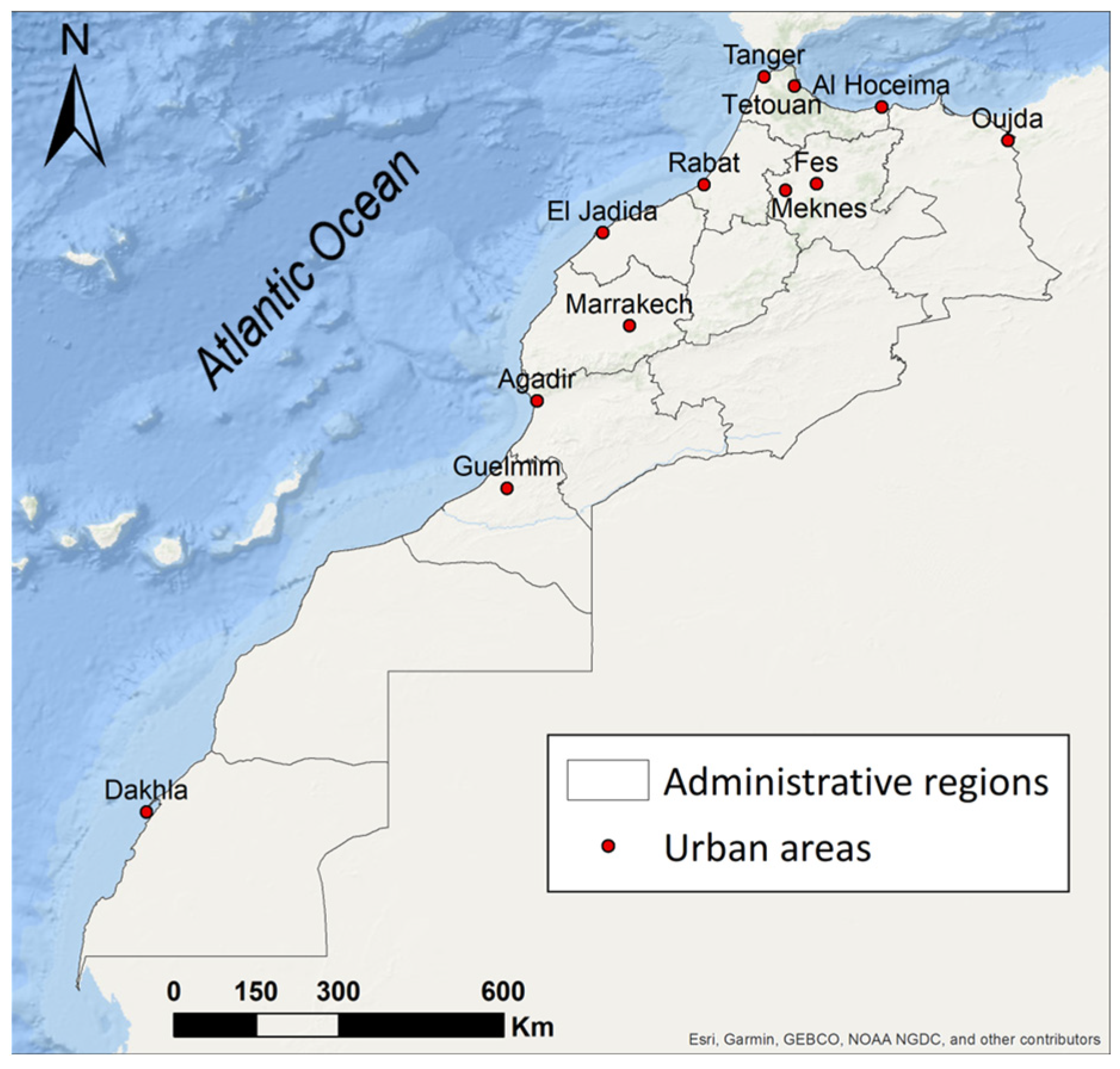
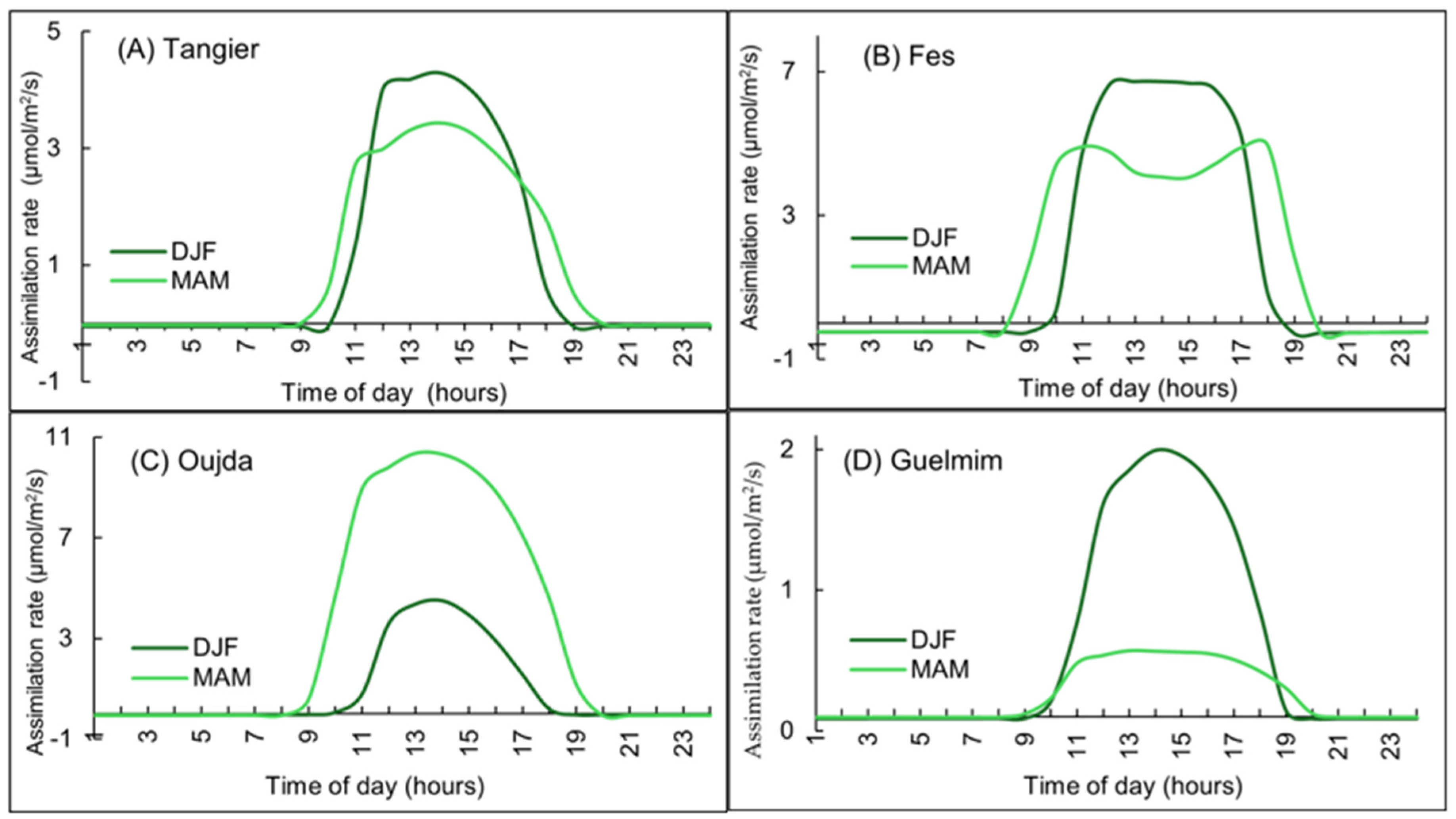
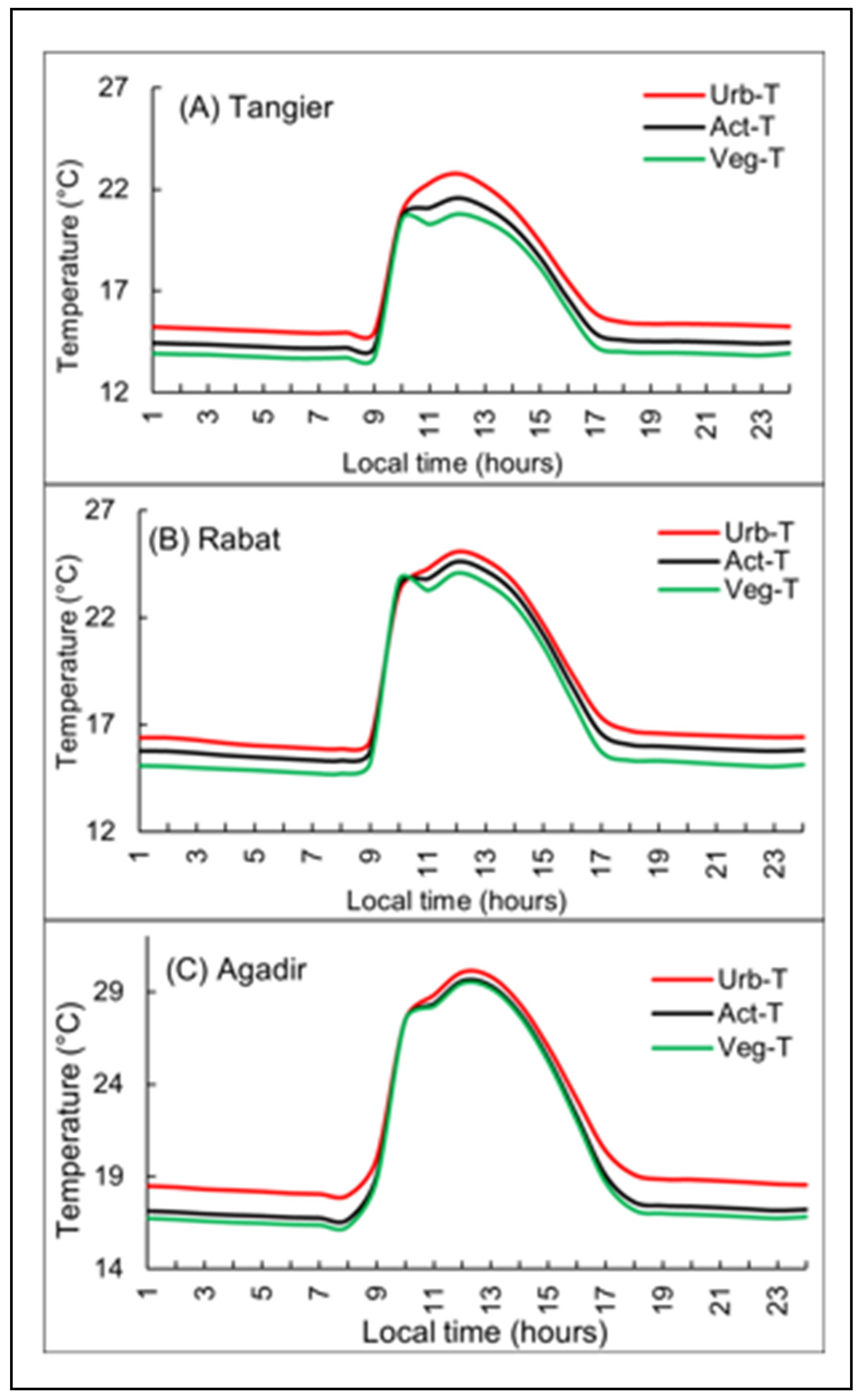

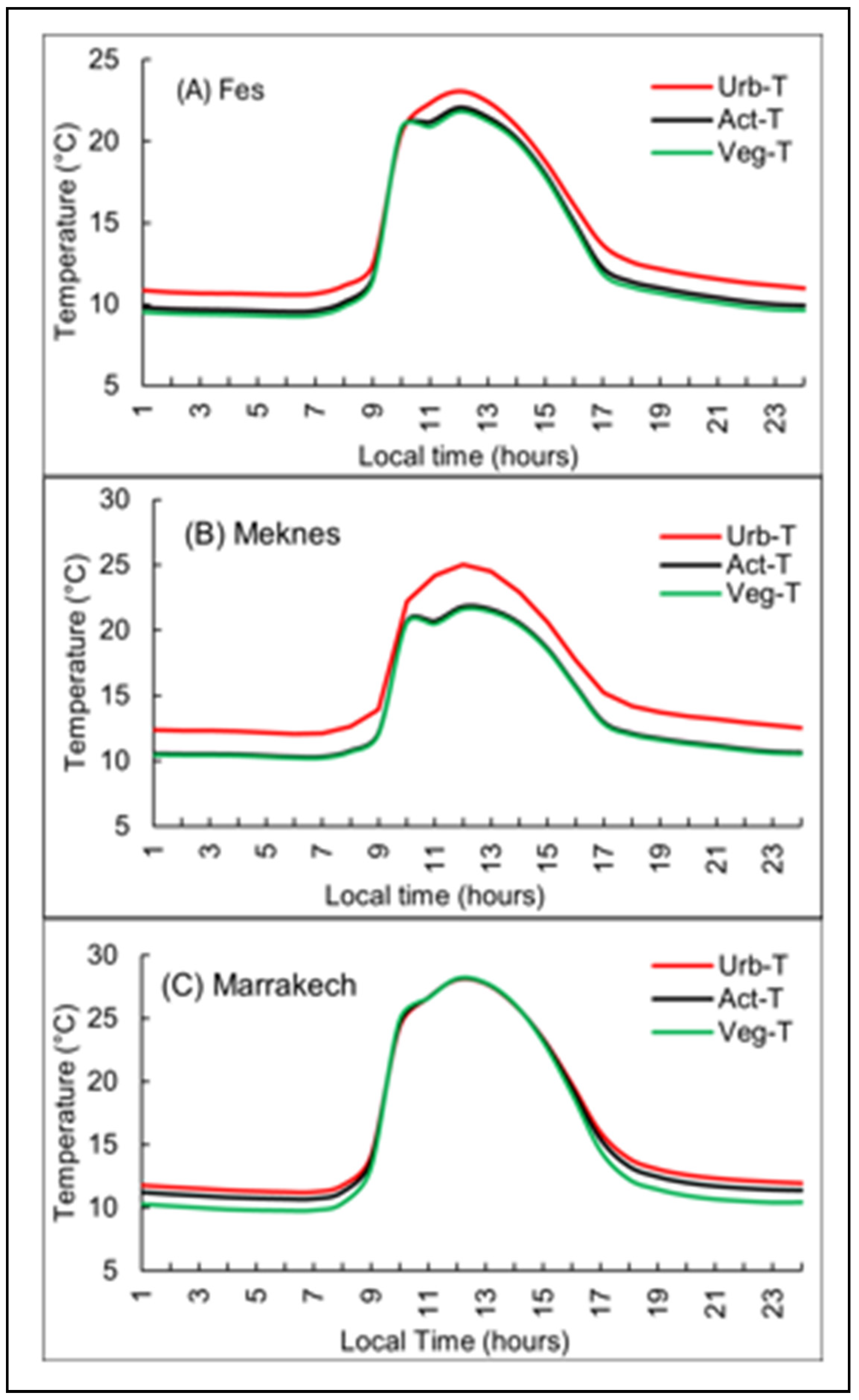
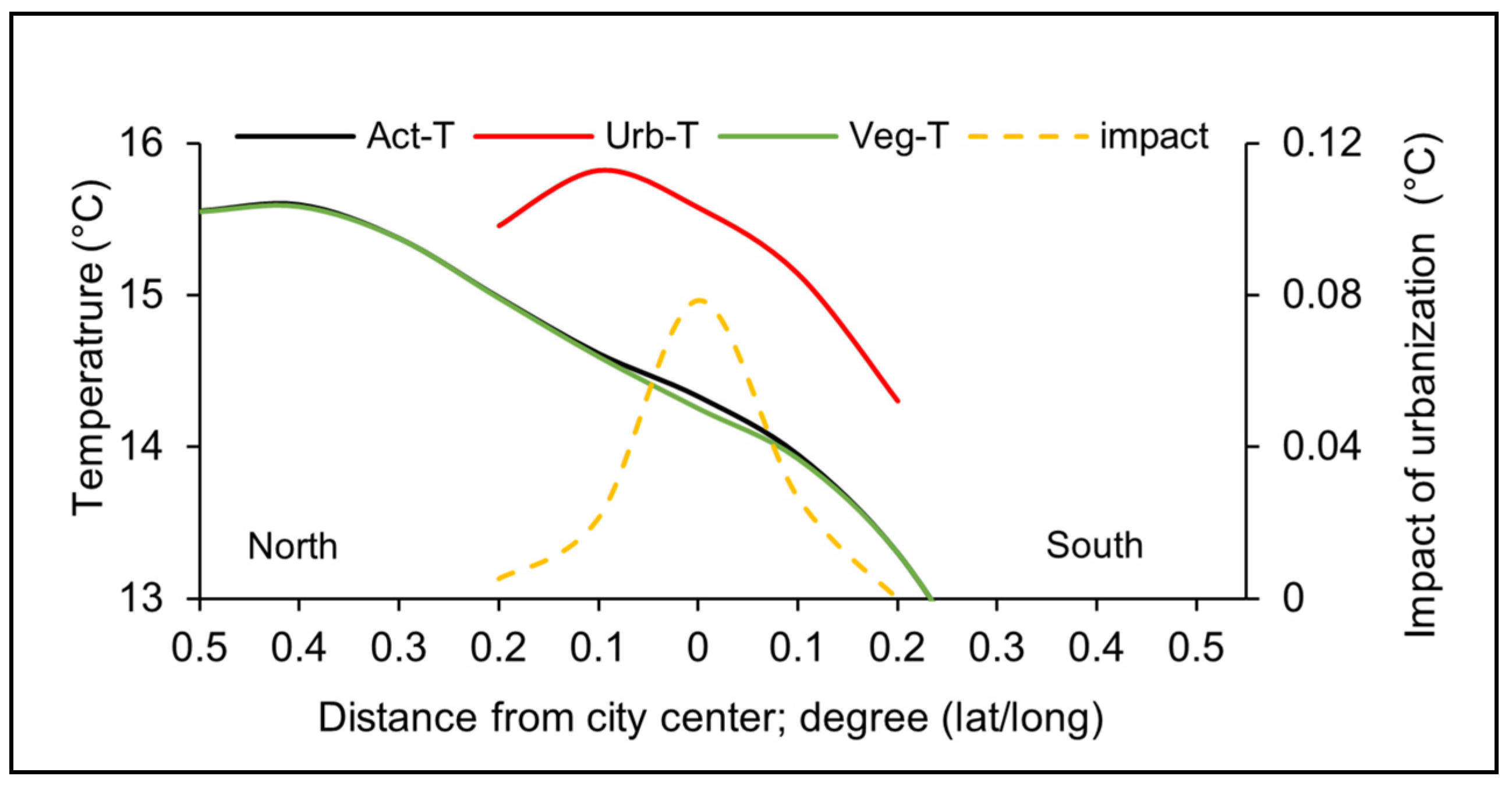
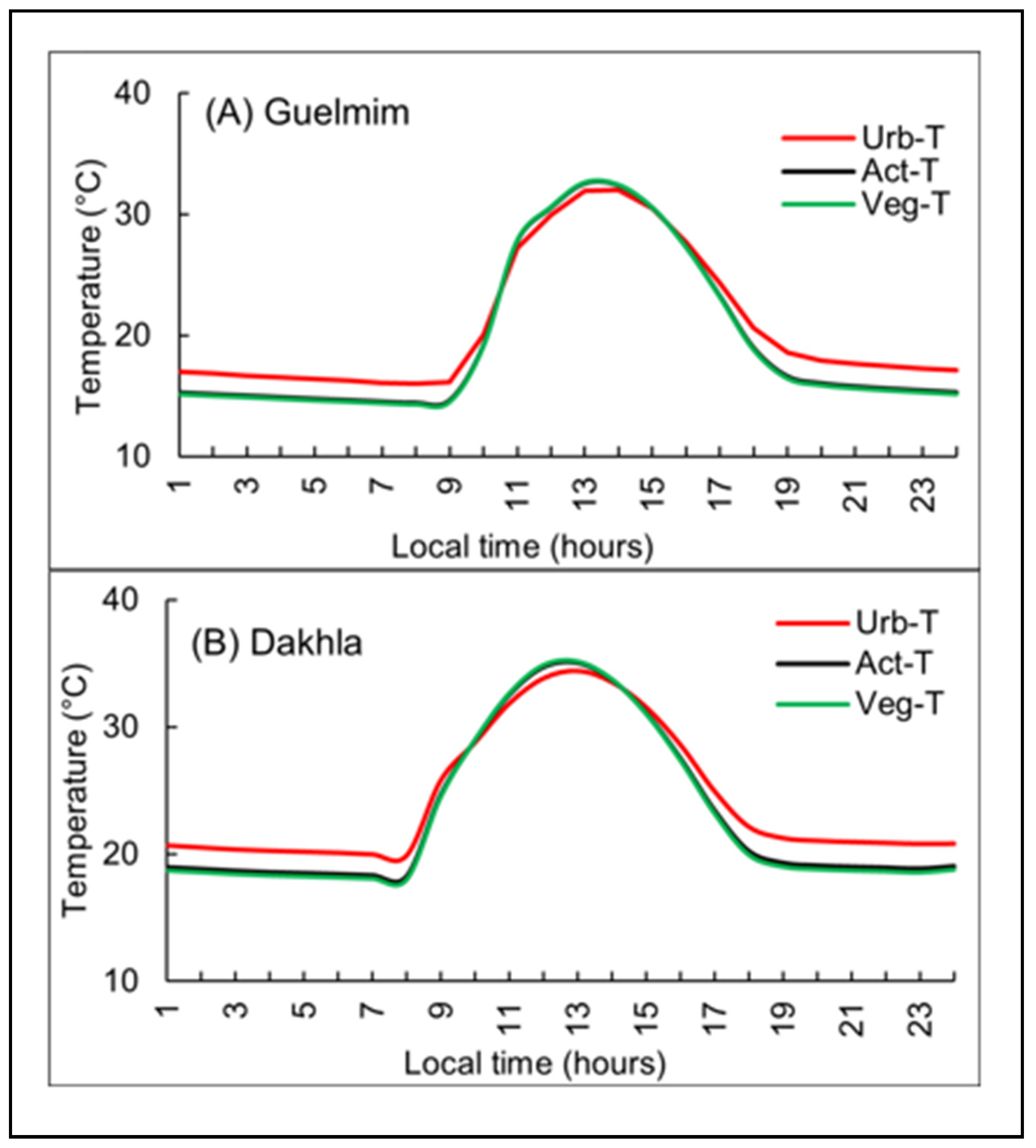
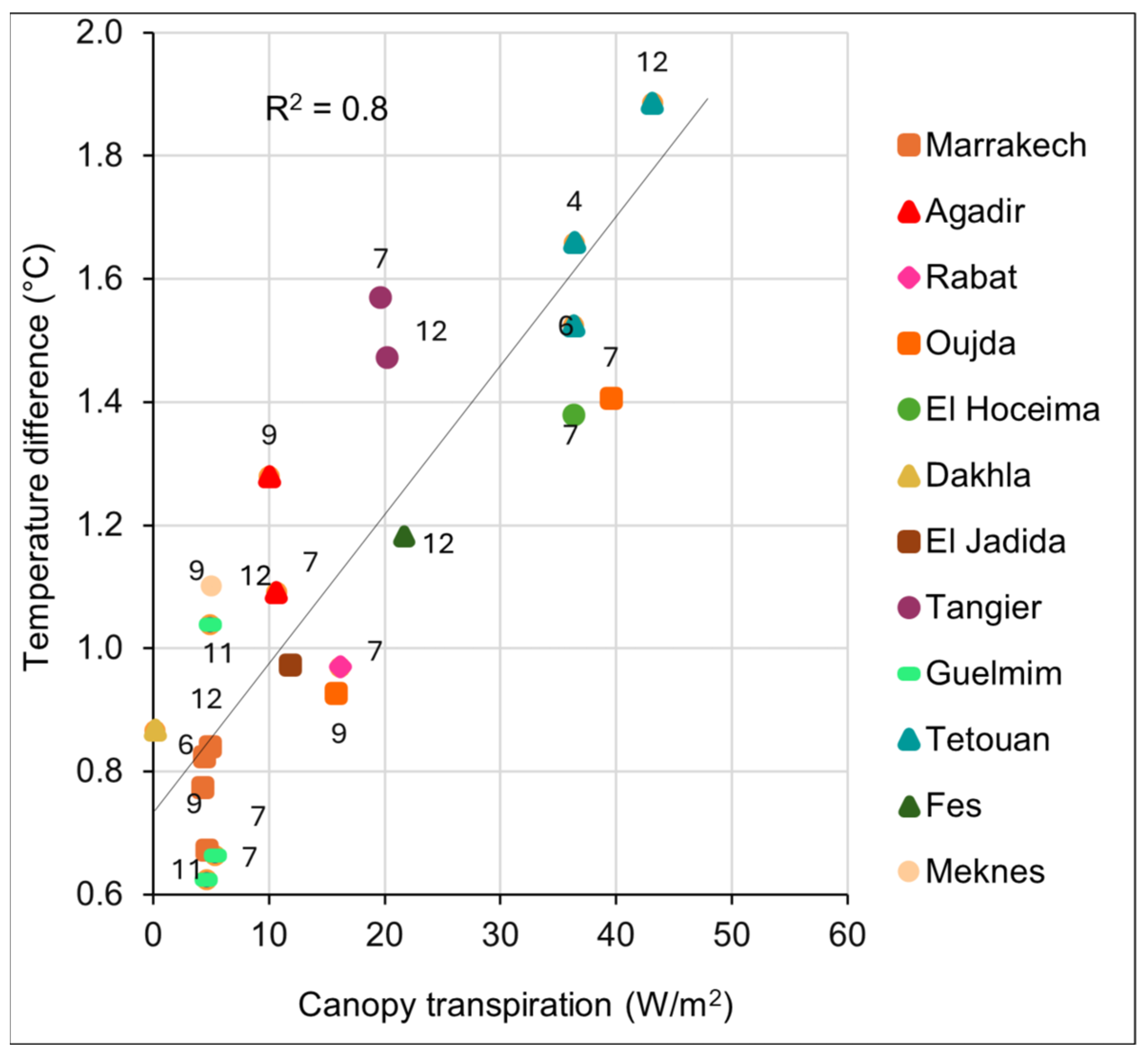
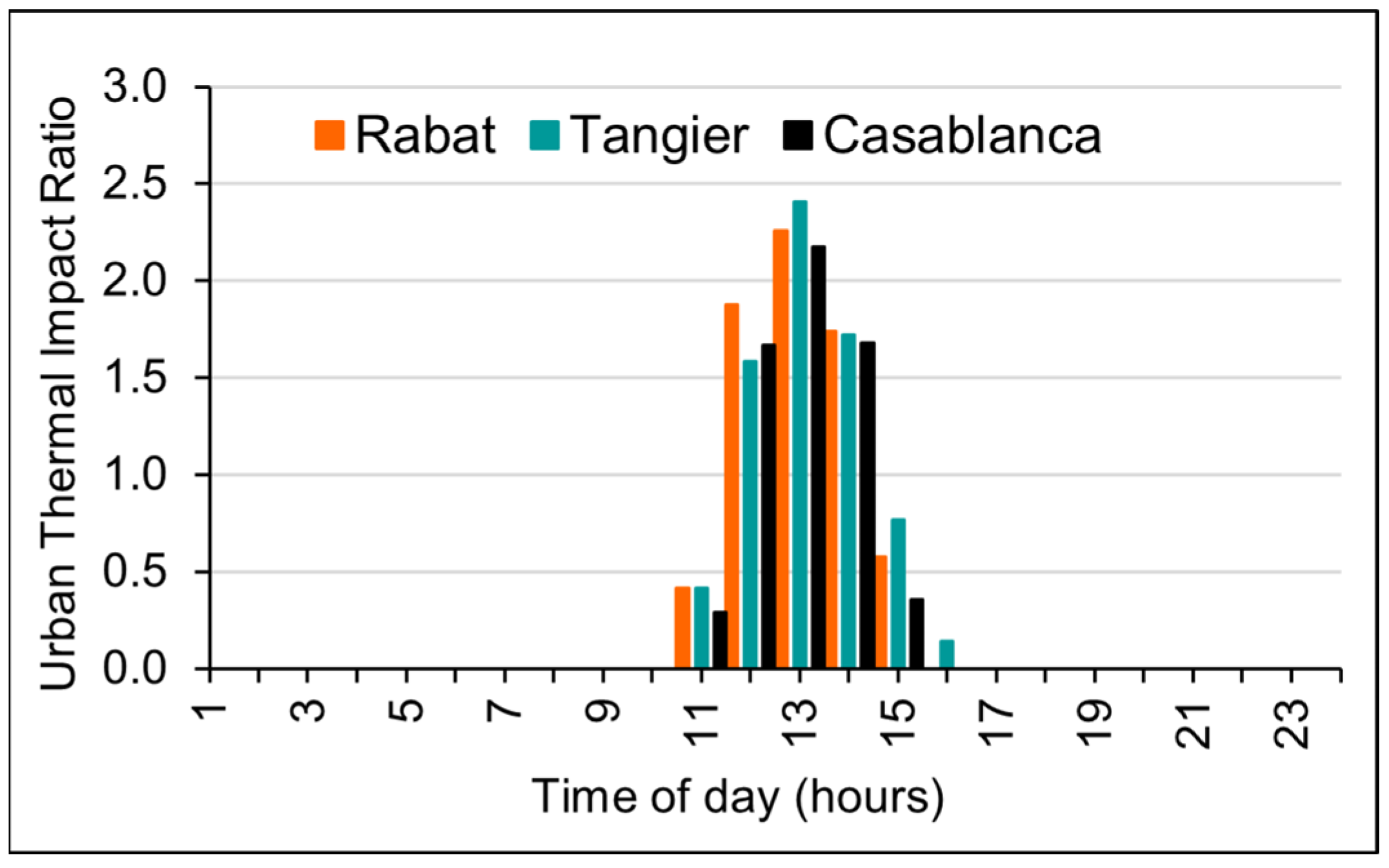
| Tangier | Rabat | Agadir | Dakhla | Oujda | Alhoceima | Tetouan | Fes | Meknes | Marrakech | |
|---|---|---|---|---|---|---|---|---|---|---|
| 8–10 a.m. | 0.9 | 0.6 | 1.0 | 1.0 | 0.5 | 0.1 | 1.5 | 0.5 | 1.8 | 0.6 |
| 11 a.m.–2 p.m. | 1.8 | 1 | 0.7 | −0.7 | 1.1 | 0.6 | 2.2 | 1 | 3.2 | 0.0 |
| 3 p.m.–5 p.m. | 1.4 | 1.3 | 1.2 | 1.2 | 1.6 | 1.2 | 1.6 | 1.1 | 2.2 | 0.8 |
| 8 p.m.–7 a.m. | 1.3 | 1.3 | 1.8 | 2.1 | 1.8 | 1.8 | 1.8 | 1.1 | 2 | 1.6 |
| Region | Characteristics | Tu | Tc | Tr | UTIR | Comfort Level |
|---|---|---|---|---|---|---|
| Tangier-Tetouan-Al Hoceima | Coastal/Mediterranean | 28 | 27 | 26.2 | 0.56 | Comfortable |
| L’Oriental | Inland Semi-Arid | 36 | 28 | 32.2 | 2.37 | Mild Discomfort |
| Fes-Meknes | Inland/Continental Influence | 36 | 28 | 32.3 | 2.43 | Mild Discomfort |
| Rabat-Sale-Kenitra | Coastal/Atlantic Influence | 30 | 27 | 25 | 0.60 | Comfortable |
| Beni Mellal-Khenifra | Mountain/Inland | 36 | 27 | 32.5 | 2.57 | Discomfort |
| Casablanca-Settat | Coastal Urban Area | 29 | 26 | 26 | 0.67 | Comfortable |
| Marrakech-Safi | Inland Semi-Arid | 38 | 28 | 34 | 2.75 | Discomfort |
| Draa-Tafilalet | Arid/Desert | 38 | 30 | 36 | 5.50 | Severe Discomfort |
| Souss-Massa | Coastal/Arid Mix | 32 | 28 | 30 | 2.50 | Discomfort |
| Guelmim-Oued Noun | Arid | 35 | 30 | 34 | 8.00 | Severe Discomfort |
| Laayoune-Sakia El Hamra | Desert/Coastal | 36 | 30 | 33.5 | 3.60 | Severe Discomfort |
| Dakhla-Oued Ed-Dahab | Desert/Peninsula | 35 | 30 | 32.5 | 3.20 | Severe Discomfort |
| Region | UTIR | UTIR Comfort Level | WBGT (°C) | WBGT Comfort Level |
|---|---|---|---|---|
| Tangier-Tetouan-Al Hoceima | 0.56 | Comfortable | 25 | Comfortable |
| L’Oriental | 2.37 | Mild Discomfort | 27.9 | Mild Discomfort |
| Fes-Meknes | 2.43 | Mild Discomfort | 27.8 | Mild Discomfort |
| Rabat-Sale-Kenitra | 0.6 | Comfortable | 25 | Comfortable |
| Beni Mellal-Khenifra | 2.57 | Discomfort | 28.3 | Discomfort |
| Casablanca-Settat | 0.67 | Comfortable | 25 | Comfortable |
| Marrakech-Safi | 2.75 | Discomfort | 31 | Severe Discomfort |
| Draa-Tafilalet | 5.5 | Severe Discomfort | 32.5 | Severe Discomfort |
| Souss-Massa | 2.5 | Discomfort | 28.5 | Discomfort |
| Guelmim-Oued Noun | 8 | Severe Discomfort | 32.5 | Severe Discomfort |
| Laayoune-Sakia El Hamra | 3.6 | Severe Discomfort | 31.5 | Severe Discomfort |
| Dakhla-Oued Ed-Dahab | 3.2 | Severe Discomfort | 31.5 | Severe Discomfort |
Disclaimer/Publisher’s Note: The statements, opinions and data contained in all publications are solely those of the individual author(s) and contributor(s) and not of MDPI and/or the editor(s). MDPI and/or the editor(s) disclaim responsibility for any injury to people or property resulting from any ideas, methods, instructions or products referred to in the content. |
© 2025 by the authors. Licensee MDPI, Basel, Switzerland. This article is an open access article distributed under the terms and conditions of the Creative Commons Attribution (CC BY) license (https://creativecommons.org/licenses/by/4.0/).
Share and Cite
Ed-dahmany, N.; Bounoua, L.; Lachkham, M.A.; Yacoubi Khebiza, M.; Bahi, H.; Messouli, M. Interplay Between Vegetation and Urban Climate in Morocco—Impact on Human Thermal Comfort. Urban Sci. 2025, 9, 289. https://doi.org/10.3390/urbansci9080289
Ed-dahmany N, Bounoua L, Lachkham MA, Yacoubi Khebiza M, Bahi H, Messouli M. Interplay Between Vegetation and Urban Climate in Morocco—Impact on Human Thermal Comfort. Urban Science. 2025; 9(8):289. https://doi.org/10.3390/urbansci9080289
Chicago/Turabian StyleEd-dahmany, Noura, Lahouari Bounoua, Mohamed Amine Lachkham, Mohammed Yacoubi Khebiza, Hicham Bahi, and Mohammed Messouli. 2025. "Interplay Between Vegetation and Urban Climate in Morocco—Impact on Human Thermal Comfort" Urban Science 9, no. 8: 289. https://doi.org/10.3390/urbansci9080289
APA StyleEd-dahmany, N., Bounoua, L., Lachkham, M. A., Yacoubi Khebiza, M., Bahi, H., & Messouli, M. (2025). Interplay Between Vegetation and Urban Climate in Morocco—Impact on Human Thermal Comfort. Urban Science, 9(8), 289. https://doi.org/10.3390/urbansci9080289





